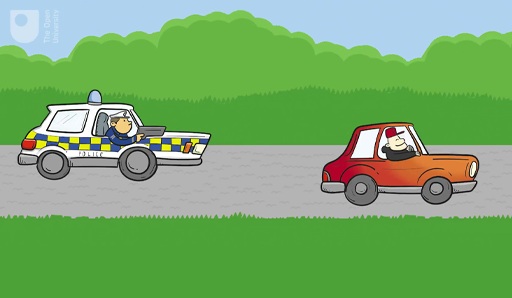3 Speed of light revisited
With the length of the second firmly tied to atomic physics, rather than the rotation of the Earth, surely time is now well and truly nailed down? Unfortunately, no it isn’t! To find out why, you will need to revisit the speed of light.
Suppose you’re a police officer wanting to use a radar or laser gun to measure the speed of traffic. It’s no good using the gun when you’re driving along, as that would only give you the relative speed between your car and the other cars on the road. To measure the speed of a suspect vehicle correctly, you must be standing motionless beside the road.
Watch this short video in which Marcus introduces relative speed, then have a go at the calculations yourself in Activity 1.

Transcript: Video 2 Relative speed (part 1)
Activity 1 Relative speeds
a.
50 km/h
b.
100 km/h
c.
150 km/h
d.
200 km/h
The correct answer is b.
a.
50 km/h
b.
100 km/h
c.
150 km/h
d.
200 km/h
The correct answer is c.
a.
50 km/h
b.
100 km/h
c.
150 km/h
d.
200 km/h
The correct answer is a.
Discussion
Relative speeds are calculated by adding the two speeds when they are in opposite directions and by subtracting when they are in the same direction. Therefore the relative speeds, as measured by the radar gun, are calculated as follows:
- a.0 + 100 = 100 km/h
- b.50 + 100 = 150 km/h
- c.100 - 50 = 50 km/h
These results line up with the intuition that a head-on collision has a much higher impact than hitting a car driving in the same direction. But only in the first scenario above does the relative speed match the actual speed of Car B.
Returning to the speed of light: where should we stand to measure it? Again, imagine three scenarios:
- a.A stationary physicist measures the speed of a light beam travelling toward them.
- b.A physicist moving at half the speed of light measures a light beam travelling toward them.
- c.A physicist moving at half the speed of light measures a light beam travelling away from them.
Following on from the police car scenarios, you might imagine that the relative speeds here would be 1.0, 1.5 and 0.5 times the speed of light. This would seem logical, but it’s not right! In all three cases the physicist would register the speed of the light beam as exactly the same value, measuring it at 3 × 108 m/s. As this is a special value which is used all the time in science, it is generally written as just c.
Here’s Marcus again to discuss this development.

Transcript: Video 3 Relative speed (part 2)
This will all begin to make sense again – but not before you reconsider the nature of time.
